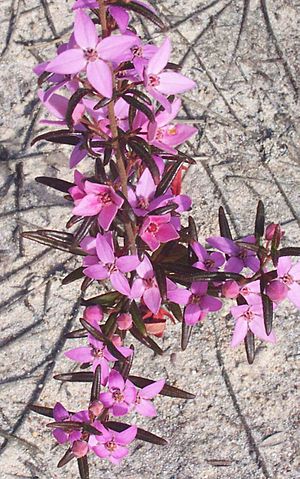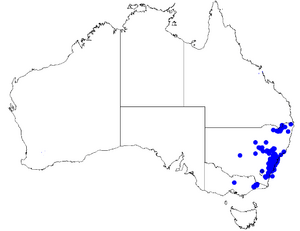Sydney boronia facts for kids
Quick facts for kids Sydney Boronia |
|
|---|---|
 |
|
| Boronia ledifolia in Ku-ring-gai Chase National Park | |
| Scientific classification | |
 |
|
| Where Sydney Boronia grows in Australia (data from Australasian Virtual Herbarium) |
The Boronia ledifolia, often called the Sydney boronia, showy boronia, or ledum boronia, is a beautiful plant. It belongs to the citrus family called Rutaceae. This plant grows naturally only in south-eastern Australia. It is a shrub, which means it's a woody plant smaller than a tree. Its leaves can be simple or have several parts, and they smell strong if you crush them. The flowers are usually pale to bright pink. Even though it can be tricky to grow, the Sydney boronia is a popular plant for gardens.
Contents
What it Looks Like
The Sydney boronia is a shrub that can grow from about 0.3 to 2.5 meters (1 to 8 feet) tall. Its thinnest branches are covered with soft, matted hairs.
Leaves
The leaves are usually simple, meaning they are one piece. Sometimes, they can be pinnate, which means they have three to seven smaller leaf parts called leaflets. These leaves or leaflets are narrow and shaped like an oval or rectangle. They are usually 3 to 43 millimeters (0.1 to 1.7 inches) long and 1 to 7 millimeters (0.04 to 0.3 inches) wide. The top side of the leaves is dark green and smooth (glabrous). The bottom side is a lighter green with a thin layer of matted hairs. You can also see a clear vein running down the middle of the underside.
Flowers and Fruit
The flowers of the Sydney boronia are usually pale to bright pink. Sometimes, they are white. They grow in groups of up to 35 flowers, but usually there are 3 to 6 flowers together. These groups grow where the leaf meets the stem (called a leaf axil).
Each group of flowers grows on a short stem called a peduncle, which is 1 to 10 millimeters (0.04 to 0.4 inches) long. Each individual flower has its own small stalk, about 6 to 11 millimeters (0.2 to 0.4 inches) long. The small, leaf-like parts at the base of the flower, called sepals, are egg-shaped or triangular. They are about 3 to 4.5 millimeters (0.1 to 0.2 inches) long. The four petals of the flower are 5 to 12 millimeters (0.2 to 0.5 inches) long.
This plant flowers in spring and early summer. After flowering, it produces a fruit called a follicle, which is a dry fruit that splits open on one side. These follicles are about 4 to 5 millimeters (0.16 to 0.20 inches) long.
How it Got its Name
The Sydney boronia was first officially described in 1803 by a French botanist (a scientist who studies plants) named Étienne Pierre Ventenat. He first called it Lasiopetalum ledifolium. Later, in 1824, another botanist named Augustin de Candolle changed its name to Boronia ledifolia.
The second part of its scientific name, ledifolia (which is called the specific epithet), means "leaves like Ledum". This is because its leaves look a bit similar to plants in the genus Ledum.
Where it Grows
The Sydney boronia mostly grows south of Scone in Australia. However, there are also some separate groups of these plants (called disjunct populations) in the Torrington and Bolivia Hill areas. It is quite rare in Victoria, where it can be found in parts of the Gippsland region. This plant usually grows in poor soils that are on top of sandstone or granite rocks. You can find it in areas of heath (open land with small shrubs) and forest.
Growing Sydney Boronia
Many types of Boronia plants can be sensitive to a problem called dieback, where parts of the plant start to die. This means they often don't live very long when grown in gardens.
If you want to grow Sydney boronia, it needs a spot that gets plenty of sunshine. The soil should be moist but also drain water well, so the roots don't sit in soggy ground.
See also
 In Spanish: Boronia ledifolia para niños
In Spanish: Boronia ledifolia para niños

